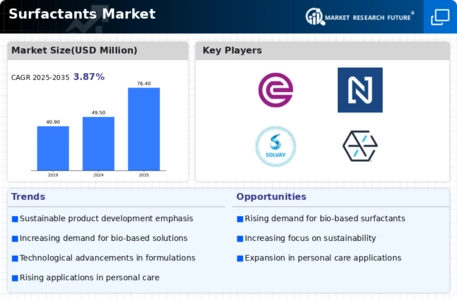Top Industry Leaders in the Surfactants Market
 Surfactants, those amphiphilic molecules that bridge the gap between oil and water, play an invisible yet crucial role in our everyday lives. From sparkling dishes to fluffy shampoos and efficient paints, their presence permeates countless industries. This ubiquitous reach translates to a surfactants market brimming with activity. But who are the key players churning up this lucrative lather, and what strategies are they deploying to grab a bigger share of the pie? Let's dive into the surfactants market's competitive landscape.
Surfactants, those amphiphilic molecules that bridge the gap between oil and water, play an invisible yet crucial role in our everyday lives. From sparkling dishes to fluffy shampoos and efficient paints, their presence permeates countless industries. This ubiquitous reach translates to a surfactants market brimming with activity. But who are the key players churning up this lucrative lather, and what strategies are they deploying to grab a bigger share of the pie? Let's dive into the surfactants market's competitive landscape.
Key Players and their Maneuvers:
-
Global Giants: Henkel, BASF, Stepan Company, and Solvay Group hold court as established titans. They wield immense production capacities, diverse product portfolios encompassing a range of surfactant types (anionic, cationic, nonionic, and amphoteric), and established distribution networks. BASF, for instance, leverages its extensive research and development capabilities to continuously innovate and cater to niche applications.
-
Regional Champions: Companies like Kao Corporation in Japan and Wilmar in Asia Pacific capitalize on their regional expertise and understanding of local market preferences. Kao, for example, excels in the personal care segment, offering high-performance and eco-friendly surfactants for cosmetics and cleaning products.
-
Specialty Players: Companies like Croda International and Ecolab carve a niche by focusing on specific surfactant types or catering to highly specialized applications. Croda specializes in high-value, bio-based surfactants for personal care and food industries, while Ecolab focuses on formulating cleaning and sanitation solutions for institutional markets.
Factors Lathering Up Market Share:
-
Product Innovation and Diversification: Continuously developing new surfactant types with improved performance, sustainability, and environmental profiles is crucial for market dominance.
-
Cost Optimization and Supply Chain Efficiency: Streamlining production processes, sourcing raw materials cost-effectively, and building robust distribution networks are key to staying competitive.
-
Sustainability and Environmentally Conscious Solutions: Growing consumer awareness and regulatory pressure drive demand for biodegradable and bio-based surfactants.
-
Focus on Specialized Applications: Meeting the specific needs of diverse industries like oil and gas, agriculture, and pharmaceuticals offers lucrative opportunities for dedicated players.
Key Companies in the Surfactants Market include
- Galaxy Surfactants Ltd
- Stepan Company
- Solvay
- KAO Corporation (Japan)rwe3e
- Huntsman Corporation
- Evonik Industries AG
- El Dupont De Nemours & Co
- Clariant AG
Recent News
CARINEX and LIVINEX, two brands aimed at expanding Sasol’s sustainable portfolio, were introduced by Sasol Chemicals, a division of Sasol Ltd., in October 2023. CARINEX SL and LIVINEX SL are both biosurfactants, marking the introduction of these new brands
The Easy-Wet substrate wetting agents, which are silicone-free oligomeric alkyl polyether polyols for top-quality industrial coatings without silicones, were brought out by Ashland in October 2023. This gives them an opportunity to develop new coatings for this industry.
January 2023 saw Holiferm Limited and Sasol Chemicals, a business unit of Sasol Ltd, collaborate on developing and marketing rhamnolipids and mannosylerythritol lipids (MELs). Together, they will launch sophorolipids as another biocompatible product following their partnership in March 2022 to develop and sell one more biosurfactant. New compounds will be formulated into commercial products by Sasol and Holiferm.
September 2023: Dow collaborates with LanzaTech to launch a circular carbon capture-enabled, easily biodegradable detergent. Additionally, Dow has launched EcoSense 2470 Surfactant, which was developed in collaboration with LanzaTech Global Inc.

